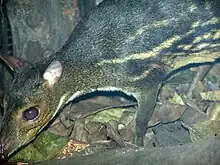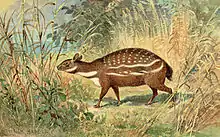Chevrotain
Chevrotains, or mouse-deer, are diminutive, even-toed ungulates that make up the family Tragulidae, and are the only living members of the infraorder Tragulina. The 10 extant species are placed in three genera,[1][2] but several species also are known only from fossils.[3] The extant species are found in forests in South and Southeast Asia; a single species, the water chevrotain, is found in the rainforests of Central and West Africa.[4] They are solitary, or live in loose groupings or pairs, and feed almost exclusively on plant material.[4] Chevrotains are the smallest hoofed mammals in the world. The Asian species weigh between 0.7 and 8.0 kg (1+1⁄2 and 17+3⁄4 lb), while the African chevrotain is considerably larger, at 7–16 kg (15–35 lb).[5] With an average length of 45 cm (18 in) and an average height of 30 cm (12 in), the Java mouse-deer is the smallest surviving ungulate (hoofed) mammal, as well as the smallest artiodactyl (even-toed ungulate).[6] Despite their common name of "mouse deer", they are not closely related to true deer.
| Chevrotain Temporal range: | |
|---|---|
 | |
| Tragulus kanchil | |
| Scientific classification | |
| Domain: | Eukaryota |
| Kingdom: | Animalia |
| Phylum: | Chordata |
| Class: | Mammalia |
| Order: | Artiodactyla |
| Suborder: | Ruminantia |
| Infraorder: | Tragulina |
| Family: | Tragulidae H. Milne-Edwards, 1864 |
| Type genus | |
| Tragulus Brisson, 1762 | |
| Genera | |
In November 2019, conservation scientists announced that they had photographed silver-backed chevrotains (Tragulus versicolor) in a Vietnamese forest for the first time since the last confirmed sightings in 1990.[7][8][9]
Etymology
The word "chevrotain" comes from the Middle French word chevrot (kid or fawn), derived from chèvre (goat).[10]
The single African species is consistently known as "chevrotain".[1][4][11] The names "chevrotain" and "mouse-deer" have been used interchangeably among the Asian species,[4][12][13][14] though recent authorities typically have preferred chevrotain for the species in the genus Moschiola and mouse-deer for the species in the genus Tragulus.[1] Consequently, all species with pale-spotted or -striped upper parts are known as "chevrotain" and without are known as "mouse-deer".
The Telugu name for the Indian spotted chevrotain is jarini pandi, which literally means "a deer and a pig". In Kannada, it is called barka (ಬರ್ಕ), in Malayalam, it is called കൂരമാൻ kūramān, and the Konkani name for it is barinka. The Tamil term is சருகு மான் sarukumāṉ "leaf-pile deer". The Sinhala name meeminna roughly translates to "mouse-like deer". This was used in the scientific name of the Sri Lankan spotted chevrotain, M. meminna.
Biology
The family was widespread and successful from the Oligocene (34 million years ago) through the Miocene (about 5 million years ago), but has remained almost unchanged over that time and remains as an example of primitive ruminant form. They have four-chambered stomachs to ferment tough plant foods, but the third chamber is poorly developed. Though most species feed exclusively on plant material, the water chevrotain occasionally takes insects and crabs or scavenges meat and fish.[15] Like other ruminants, they lack upper incisors. They give birth to only a single young.
In other respects, however, they have primitive features, closer to nonruminants such as pigs. All species in the family lack antlers and horns, but both sexes have elongated canine teeth. These are especially prominent in males, where they project out on either side of the lower jaw, and are used in fights.[4] Their legs are short and thin, which leave them lacking in agility, but also helps to maintain a smaller profile to aid in running through the dense foliage of their environments. Other pig-like features include the presence of four toes on each foot, the absence of facial scent glands, premolars with sharp crowns,[16] and the form of their sexual behaviour and copulation.[17][16]
.JPG.webp)
They are solitary or live in pairs.[4] The young are weaned at three months of age, and reach sexual maturity between 5 and 10 months, depending on species. Parental care is relatively limited. Although they lack the types of scent glands found in most other ruminants, they do possess a chin gland for marking each other as mates or antagonists, and, in the case of the water chevrotain, anal and preputial glands for marking territory. Their territories are relatively small, on the order of 13–24 hectares (32–59 acres), but neighbors generally ignore each other, rather than compete aggressively.[16]
Some of the species show a remarkable affinity with water, often remaining submerged for prolonged periods to evade predators or other unwelcome intrusions. This has also lent support to the idea that whales evolved from water-loving creatures that looked like small deer.[18][19]
Taxonomy
Tragulidae's placement within Artiodactyla can be represented in the following cladogram:[20][21][22][23][24]
| Artiodactyla |
| ||||||||||||||||||||||||||||||
Traditionally, only four extant species were recognized in the family Tragulidae.[4] In 2004, T. nigricans and T. versicolor were split from T. napu, and T. kanchil and T. williamsoni were split from T. javanicus.[25] In 2005, M. indica and M. kathygre were split from M. meminna.[2] With these changes, the 10 extant species are:

.JPG.webp)
- Family Tragulidae
- Genus Hyemoschus
- Water chevrotain, Hyemoschus aquaticus
- Genus Moschiola
- Indian spotted chevrotain, Moschiola indica
- Sri Lankan spotted chevrotain, Moschiola meminna
- Yellow-striped chevrotain, Moschiola kathygre
- Genus Tragulus
- Java mouse-deer, Tragulus javanicus
- Lesser mouse-deer or kanchil, Tragulus kanchil
- Greater mouse-deer, Tragulus napu
- Philippine mouse-deer, Tragulus nigricans
- Vietnam mouse-deer, Tragulus versicolor
- Williamson's mouse-deer, Tragulus williamsoni
- Genus Hyemoschus
Ancient chevrotains

The Hypertragulidae were closely related to the Tragulidae.
The six extinct chevrotain genera[3] include:
- Genus Dorcatherium
- Dorcatherium minus from Pakistan
- Dorcatherium majus from Pakistan
- Dorcatherium naui, from Central Europe[26]
- Genus Dorcabune
- Genus Afrotragulus Sánchez, Quiralte, Morales and Pickford, 2010 [27]
- Afrotragulus moruorotensis (previously "Dorcatherium" moruorotensis Pickford, 2001) (early Miocene) from Moruorot, Kenya
- Afrotragulus parvus (previously "D." parvus Withworth 1958) (early Miocene) from Rusinga Island, Kenya
- Genus Siamotragulus
- Genus Yunnanotherium
- Genus Archaeotragulus[28]
Footnotes
- Changing taxonomy in the genus Tragulus make exact species identification uncertain, but either T. javanicus or T. kanchil. Note also the contradicting English and scientific names on the sign on the photo.
References
- Wilson, D. E.; Reeder, D. M., eds. (2005). Mammal Species of the World: A Taxonomic and Geographic Reference (3rd ed.). Johns Hopkins University Press. ISBN 978-0-8018-8221-0. OCLC 62265494.
- Groves, C.; Meijaard, E. (2005). "Intraspecific variation in Moschiola, the Indian chevrotain". The Raffles Bulletin of Zoology. Supplement 12: 413–421.
- Farooq, U.; Khan, M.A.; Akhtar, M.; Khan, A.M. (2008). "Lower dentition of Dorcatherium majus (Tragulidae, Mammalia) in the Lower and Middle Siwaliks (Miocene) of Pakistan" (PDF). Tur. J. Zool. 32: 91–98. Archived from the original (PDF) on 28 September 2011.
- Nowak, R.M., ed. (1999). Walker's Mammals of the World (6th ed.). Baltimore, MD: Johns Hopkins University Press.
- "Hyemoschus aquaticus". Ultimate Ungulate. Retrieved 12 October 2010.
- Fukuta, K.; Kudo, H; Jalaludin, S. (1996). "Unique pits on the erythrocytes of the lesser mouse-deer, Tragulus javanicus". Journal of Anatomy. 189 (1): 211–213. PMC 1167845. PMID 8771414.
- Chappell, Bill (11 November 2019). "Silver-Backed Chevrotain, with Fangs and Hooves, Photographed In Wild for First Time". NPR. NPR.org. Retrieved 12 November 2019.
- Nguyen, An (11 November 2019). "Camera-trap evidence that the silver-backed chevrotain Tragulus versicolor remains in the wild in Vietnam". Nature.com. Retrieved 12 November 2019.
- "Tiny deer-like animal spotted after 25 years" (Video). CNN. 11 Nov 2019.
- "Chevrotain". Merriam-Webster.com Dictionary. Retrieved 15 December 2019.
- IUCN SSC Antelope Specialist Group (2016). "Hyemoschus aquaticus". IUCN Red List of Threatened Species. 2016: e.T10341A50188841. doi:10.2305/IUCN.UK.2016-1.RLTS.T10341A50188841.en. Retrieved 13 November 2021.
- Duckworth, J.W.; Timmins, R. (2015). "Moschiola indica". IUCN Red List of Threatened Species. 2015: e.T136585A61979067. doi:10.2305/IUCN.UK.2015-2.RLTS.T136585A61979067.en. Retrieved 13 November 2021.
- Duckworth, J.W.; Timmins, R. (2015). "Moschiola kathygre". IUCN Red List of Threatened Species. 2015: e.T136799A61979620. doi:10.2305/IUCN.UK.2015-2.RLTS.T136799A61979620.en. Retrieved 13 November 2021.
- Duckworth, J.W.; Timmins, R. (2015). "Moschiola meminna". IUCN Red List of Threatened Species. 2015: e.T41779A73575223. doi:10.2305/IUCN.UK.2015-2.RLTS.T41779A73575223.en. Retrieved 13 November 2021.
- Kingdon, J. (1997). The Kingdon Field Guide to African Mammals. Academic Press. ISBN 0-12-408355-2.
- Dubost, G. (1984). Macdonald, D. (ed.). The Encyclopedia of Mammals. New York: Facts on File. pp. 516–517. ISBN 978-0-87196-871-5.
- Valerius Geist (1998). Deer of the World: Their Evolution, Behaviour, and Ecology. Stackpole Books. ISBN 978-0-8117-0496-0.
- Walker, M. (7 July 2009). "Aquatic deer and ancient whales". BBC News. Retrieved 26 March 2010.
- Meijaard, E.; Umilaela; de Silva Wijeyeratne, G. (September 2010). "Aquatic escape behaviour in mouse-deer provides insight into tragulid evolution". Mammalian Biology. 75 (5): 471–473. doi:10.1016/j.mambio.2009.05.007.
- Beck, N.R. (2006). "A higher-level MRP supertree of placental mammals". BMC Evol Biol. 6: 93. doi:10.1186/1471-2148-6-93. PMC 1654192. PMID 17101039.
- O'Leary, M.A.; Bloch, J.I.; Flynn, J.J.; Gaudin, T.J.; Giallombardo, A.; Giannini, N.P.; Goldberg, S.L.; Kraatz, B.P.; Luo, Z.-X.; Meng, J.; Ni, X.; Novacek, M.J.; Perini, F.A.; Randall, Z.S.; Rougier, G.W.; Sargis, E.J.; Silcox, M.T.; Simmons, N.B.; Spaulding, M.; Velazco, P.M.; Weksler, M.; Wible, J.R.; Cirranello, A.L. (2013). "The Placental Mammal Ancestor and the Post-K-Pg Radiation of Placentals". Science. 339 (6120): 662–667. Bibcode:2013Sci...339..662O. doi:10.1126/science.1229237. hdl:11336/7302. PMID 23393258. S2CID 206544776.
- Song, S.; Liu, L.; Edwards, S.V.; Wu, S. (2012). "Resolving conflict in eutherian mammal phylogeny using phylogenomics and the multispecies coalescent model". Proceedings of the National Academy of Sciences. 109 (37): 14942–14947. Bibcode:2012PNAS..10914942S. doi:10.1073/pnas.1211733109. PMC 3443116. PMID 22930817.
- dos Reis, M.; Inoue, J.; Hasegawa, M.; Asher, R.J.; Donoghue, P.C.J.; Yang, Z. (2012). "Phylogenomic datasets provide both precision and accuracy in estimating the timescale of placental mammal phylogeny". Proceedings of the Royal Society B: Biological Sciences. 279 (1742): 3491–3500. doi:10.1098/rspb.2012.0683. PMC 3396900. PMID 22628470.
- Upham, N.S.; Esselstyn, J.A.; Jetz, W. (2019). "Inferring the mammal tree: Species-level sets of phylogenies for questions in ecology, evolution, and conservation". PLOS Biology. 17 (12): e3000494. doi:10.1371/journal.pbio.3000494. PMC 6892540. PMID 31800571.(see e.g. Fig S10)
- Meijaard, I.; Groves, C.P. (2004). "A taxonomic revision of the Tragulus mouse-deer". Zoological Journal of the Linnean Society. 140: 63–102. doi:10.1111/j.1096-3642.2004.00091.x.
- Thenius, E. (1950). "Über die Sichtung und Bearbeitung der jungtertiären Säugetierreste aus dem Hausruck und Kobernaußerwald (O.Ö.)". Verh. Geol. B.-A. 51 (2): 56.
- Sánchez, Israel M.; Quiralte, Victoria; Morales, Jorge; Pickford, Martin (2010). "A new genus of tragulid ruminant from the early Miocene of Kenya" (PDF). Acta Palaeontologica Polonica. 55 (2): 177–187. doi:10.4202/app.2009.0087. S2CID 303897.
- Métais, G.; Chaimanee, Y.; Jaeger, J.-J. & Ducrocq S. (2001). "New remains of primitive ruminants from Thailand: Evidence of the early evolution of the Ruminantia in Asia" (PDF). Zoologica Scripta. 30 (4): 231. doi:10.1046/j.0300-3256.2001.00071.x. S2CID 85647031. Archived from the original (PDF) on 22 July 2011.
- Vaughan, Terry A.; Ryan, James M.; Czaplewski, Nicholas J. (21 April 2011). Mammalogy (5th ed.). ISBN 978-0-7637-6299-5. Retrieved 4 April 2012.
- Sánchez, Israel M.; Quiralte, Victoria; Morales, Jorge; Pickford, Martin (2010). "A new genus of Tragulid ruminant from the Early Miocene of Kenya". Acta Palaeontologica Polonica. 55 (2): 177. doi:10.4202/app.2009.0087.
- "Krabitherium". Paleobiology Database (Paleodb.org). Retrieved 18 January 2013.
- Mennecart, B., Wazir, W.A., Sehgal, R.K., Patnaik, R., Singh, N.P., Kumar, N. and Nanda, A.C., 2021. New remains of Nalamaeryx (Tragulidae, Mammalia) from the Ladakh Himalaya and their phylogenetical and palaeoenvironmental implications. Historical Biology, pp.1-9.https://doi.org/10.1080/08912963.2021.2014479
External links
- Lydekker, Richard (1911). . Encyclopædia Britannica (11th ed.).